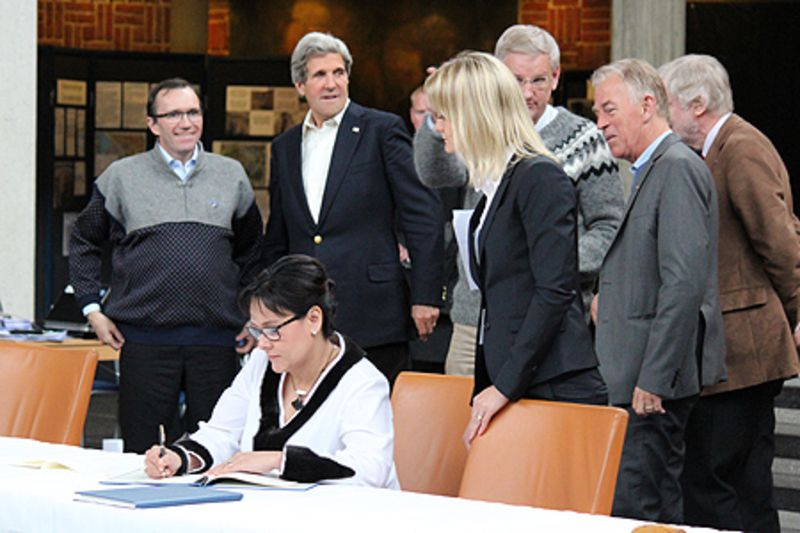What global climate deal should look like?
Adelina Marini, August 5, 2009
 Nigel Purvis, a senior Transatlantic Fellow at The German Marshall Fund of the United States is trying to find the answer to this question in his 9th consecutive blueprint. In it he claims that the US and Europe are finally finding common ground for action on climate change. Unlike past years, the transatlantic partners now agree on the severity of the climate threat, that finding solutions is urgent, as well as that developed countries should help the developing ones. Nigel Purvis supports his statement with the results from the G8 summit in Italy this July when a real progress has been achieved for common actions.
Nigel Purvis, a senior Transatlantic Fellow at The German Marshall Fund of the United States is trying to find the answer to this question in his 9th consecutive blueprint. In it he claims that the US and Europe are finally finding common ground for action on climate change. Unlike past years, the transatlantic partners now agree on the severity of the climate threat, that finding solutions is urgent, as well as that developed countries should help the developing ones. Nigel Purvis supports his statement with the results from the G8 summit in Italy this July when a real progress has been achieved for common actions.
But he thinks that there are still a lot of obstacles before the conclusion of a deal in Copenhagen which should replace the Kyoto Protocol that expires in 2012. A reason for his concern are the differences not only between the developing and developed countries but among the industrialized states as well.
What the major dispute is all about? Scientists recommend greenhouse gas emissions to be cut at least by 50% by 2050 so as to avoid unacceptable catastrophic changes in the climate. This goal is now embraced by Europe, the United States, and other major industrialized nations, and also enjoys support from major developing nations provided developed nations agree to reduce emissions at least 80 percent by 2050. And, if we look only at 2050, an agreement will most certainly not be concluded, that is why a mid-term goal has been agreed - 2020.
The good news, writes Nigel Purvis, is that the US and the EU agree on many of the important points in the mid-term agreement:
- by 2020, developed nations must substantially reduce their emissions and emerging
economies should slow the rate of growth of their emissions;
- emerging economies should have access to capital from international carbon markets when
they outperform internationally agreed upon benchmarks or other measures of success.
However, the bad news is that the points that both developed and developing countries disagree are much more. For example, developed states agree that they should reduce their emissions by 25–40% below 1990 levels by 2020. The EU promises to cut its emissions by 30% by 2020 but if a global deal is achieved in Copenhagen in December. If there is no deal, the engagement of the EU is 20% cuts. And the emerging markets insist that 25-40% cuts is insignificant and want more.
In a harsh contrast the administration of president Barack Obama engaged after 2 decades of inaction to cut US emissions by 28% by 2020 from 2005 level and 14% from 1990 level. This happened with the new cap and trade bill, approved by the House of Representatives but still pending approval by the Senate.
The problem is that this position is not quite fair given the fact that this would merely return U.S. emissions to 1990 levels by 2020. Thus they will make no cuts at all. Compared to Europe's ambitions, the US target is much less ambitious because emissions in Europe from 1990 to 2005 were relatively flat whereas emissions in the United States rose dramatically. For Bulgaria, in fact, the 2005 metric is also not very good because by then the economy of Bulgaria reached almost full collapse while in 1990 quite a lot of industries still worked in full capacity.
Nigel Purvis also notes that if the US would agree to make the cuts based on 1990 levels, this might well serve as a strong argument for most of the developing countries to follow the example and agree on more ambitions targets. It is not impossible that India also might give up its determined position to ask for 10 years transition period during which no one would ask any cuts from New Delhi. Besides, if the US do not take more drastic measures, the European business might put the EU under pressure and ask for a retreat from the 30% goals which, in the study of the German Marshall Fund of the United States is shown as a solid engagement but, as mentioned above, it is conditional. The solid engagement is for 20%.
Thus, the Europeans face a real dilemma. They will have to decide whether to embrace the eventual U.S. target as equitable, or hold out for comparability based on a 1990 base year at the risk of leaving the United States behind, giving emerging economies an excuse for inaction. Here there's another thing, that hasn't been included in the study of the German Marshall Fund and it is that the EU will not be a side on the Copenhagen agreement as a political entity. Member states will sign it separately.
This is the reason why some of them like France and Britain, and outside the Eu - Russia, to have started developing their own national plans and positions for the Copenhagen conference on the 7th of December. (euinside i expecting to receive the position of Bulgaria by the end of the week)
 That is why Nigel Purvis recommends several steps that might help a global compromise to be reached. The first is the development of national plans. By the way Bulgaria still hasn't got one or at least we don't know of any. All big emitters should register with the international community their ambitions by 2020. Then a measurement, reporting, and verification mechanism should be established. Mr. Purvis also recommends the creation of an international legal form as well as international review of domestically enforceable plans be allowed.
That is why Nigel Purvis recommends several steps that might help a global compromise to be reached. The first is the development of national plans. By the way Bulgaria still hasn't got one or at least we don't know of any. All big emitters should register with the international community their ambitions by 2020. Then a measurement, reporting, and verification mechanism should be established. Mr. Purvis also recommends the creation of an international legal form as well as international review of domestically enforceable plans be allowed.
And one more very important measure - access to carbon markets. The blueprint says that the access to global carbon markets should be limited to nations that have negotiated sector- or economy-wide emission reduction baselines or reference scenarios with the international community. Nations that improve these agreed upon reference cases should be eligible to sell
verified emission reductions to the private sector. In other words, given the current carbon trading scheme, countries like Bulgaria would benefit because of its industrial collapse and the great quantity of free quotas which can be sold without limits to the private sector.
There is one more issue that remains unsolved ahead of Copenhagen and that is the financial aid which industrialized world is ready to give to the emerging markets. The positions of Europe and the US are close this time too but without specific sums being mentioned. the EU, according to Nigel Purvis has calculated that annually some $150-200 bn will be necessary by 2020 for greenhouse gas emissions reduction and for the adaptation of the developing countries to climate change. The US has still not announced any estimations. It is also not clear how the money will be shared among the developed countries. Past practice in other areas of international cooperation suggests that together Europe and the United States could account for approximately 50 percent of developed country contributions.
The developing countries also don't have common position. China and several other countries have proposed that developed nations should accept binding international obligations to provide 0.5–1 percent of GDP which would amount to $200–400 billion globally from donor nations, including $70–140 billion annually for both Europe and the United States.
As you may see the differences appear to be more than the common visions bu if we compare the current situation with the negotiations on previous global agreements we will see that this time the common grounds are much more. Either because of the more and more hot summers in the last years or the frequent floods and storms or because of the severe financial and economic crisis, it is hard to say. But one thing is certain - the conclusion of a deal in Copenhagen in December could be compared to the conclusion of a global piece treaty for sustainable economic and ecological development as ambitious this might sound. Because for the first time, the responsibilities of all global players will be written on a paper.
 | © Government of Sweden
| © Government of Sweden | © КРИБ
| © КРИБ | © euinside
| © euinside